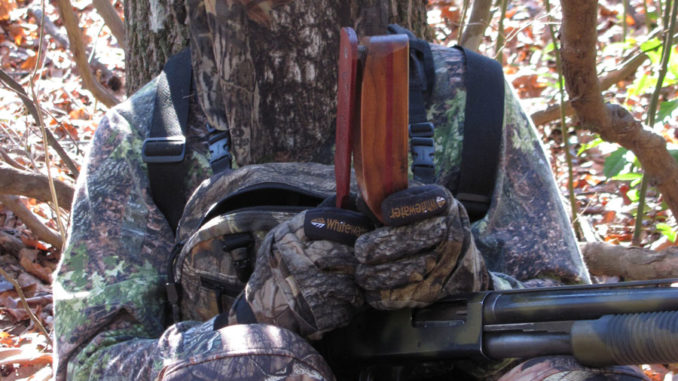
Be patient, know your woods and calls, and be patient some more, and you’ll take more turkeys.
Working as a turkey guide inherently gives a person more insight into the sport. They hunt nearly every day of the season and often have the luxury of not shooting a bird, but calling for another person to do the shooting.
The term “luxury” refers to the opportunity they have to watch both a gobbler’s approach and a hunter’s reactions. They glean a tremendous amount of knowledge on turkeys and hunters, and that will make anyone more proficient in the sport. Even when they hunt alone, they hone techniques and specific strategies for particular situations they’ll encounter during the season.
These pros accumulate a vast amount of knowledge about what to do, or not to do, in a season than most hunters do in a lifetime. They develop strategies that are battle-tested and produce consistent results.
We’ll look at five top tips from top South Carolina turkey hunting pros.
Don’t “push” a gobbler
Terry Hiers, who has guided for more than 30 of his 57 years, runs the Blackwater Hunting Services in Ulmer. He said hunters can do a lot of things to improve their hunting, but one mistake they make is to push or rush a gobbler too much. He said that’s especially true in the morning.
“Early in the season, hunters are anxious, and it’s natural to want things to happen quickly,” Heirs said. “It is a very good thing to get in tight to a gobbler while he’s still perched in the tree in total darkness, but that’s often not possible. Most of the time, pushing too deep — even under cover of darkness — will booger the entire situation up by alerting the gobbler or hens and making him wary and overtly cautious.”
Hiers (803-671-4868) said the potential for a good ending to the hunt is to let things occur naturally and allow nature to take its course as much as possible.
“A good example is trying to rush the gobbler to gobble first thing in the morning,” Hiers said. “After all the years I’ve hunted turkeys, I’ve found that it’s best to let a gobbler make the first gobble on his own if he will. I don’t even try to owl hoot at a gobbler until it has gotten light enough for a bird to gobble.
“I’ve found that even if I force a gobble by owling just 10 minutes too early, it puts that gobbler on guard, and the odds of killing him go down. There’s a natural order of things in the woods and when it’s time for him to gobble, he should gobble. But only at that time or slightly later will I stir the pot by using my owl call if there hasn’t been a gobble. If he responds to the owl call I can make my move just as I would if he gobbles on his own.
“I much prefer that the turkey gobble without any prompting by a hen call first thing in the morning. Then I can move, get a good setup position and be ready for him when I start using hen calls. This type of patience is not easy; I’ve had to learn it through tough experiences, but this does have a positive impact anytime of the season.”
Hiers said another key to not pushing a gobbler too hard is to always keep human intrusion changing so you don’t create a pattern — including how you get into and out of the woods.
“When I am preseason scouting and even into the actual season, I always try to use different parking areas and travel routes,” he said. “One day, I may park and walk in from one direction, the next I may park at the total opposite end and approach that way. I may be listening in the same general area with some overlap, but I don’t want to overdo a specific pattern of travel. Too much of the same thing from a hunter will also push a gobbler to become more wary and to pattern a person’s behavior. The gobbler has a natural way of working in his daily routine, and I don’t want to interfere in that. My chances of having a hunter with me be successful is much higher on birds that are acting naturally as opposed to those pushed or pressured by external factors.
“The bottom line is, if things happen naturally and in the right order of time, the odds of my client and I leaving the woods with a gobbler slung over the shoulder are much higher than trying to rush and be done in short order,” Hiers said.
Hunting creek bottoms
Guide Jamie Pritchard from Marietta is an expert in hunting creek bottoms; one reason is that he generally hunts the upper piedmont and in the mountains. Thus, his strategies often involve hunting bottoms, which are ideal turkey habitats.
“One of the keys is setup,” Pritchard said. “It’s easier said than done because you want to be able to see as far as you can while being concealed as much as possible. When guiding, I’ve got to be able to do it with two people. I need to be able to see the person who will be shooting as well as the gobbler so I’ll know what type of call to make. If it sounds complicated, it is in a way, but it’s also fairly straightforward.”
Pritchard (864-238-3811) said creek bottoms are ideal areas to hunt turkeys all day because they are natural travel routes.
“I love to hear a gobble early in the morning in a creek bottom or on a ridge alongside the creek,” he said. “Odds are good if you get set up in the bottom, you’ll have a good opportunity to get that gobbler. They work that way often because it is a natural travel corridor for them and being where they already want to go is one of the keys to taking a gobbler any time.”
Pritchard said another key to hunting creek bottoms is that it can also serve as a bit of a funnel for the gobblers.
“If I don’t score early, I’ll often get in a creek bottom and set up against a big tree,” he said. “If I set up right, my client can shoot 40 yards in either direction, a total of 80 yards, and often that covers much of the entire flatter area of the bottom. If you can find an area that narrows down and set up where you can shoot to both sides, you’ll increase your odds tremendously.
“I’ll call soft at first in case a gobbler is close, then I’ll call louder to spark attention from a far-off gobbler. The soft calls are clucks, purrs and soft yelps. Loud calls are cuts and loud yelps. I’ll give it 20 minutes and usually run another series of calls and wait again before moving. I’ll also look for a gobbler that may approach silently. Since they are comfortable traveling in bottoms they often do that.”
Hunting swamps
Chris Orvin of Moncks Corner has been hunting gobblers since he was a youngster and has been guiding for three years. He loves to hunt swamps, and over the course of his hunting and guiding, he’s developed some excellent strategies. Some unique tactics he uses can improve hunters’ odds.
“I do a lot of hunting in swamps, and some keys to success seem simple but are overlooked by most hunters,” Orvin said. “Swamps are great places to hunt because there is water, and gobblers love to roost over or near water. But swamps are often fairly open, especially early in the season before the foliage greens, so I get into the swamp and to the place I want to listen or set up very early, long before any light. I take a route in that I think will not lead me past any gobblers, and I’ll generally park a long distance away.”
Orvin (843-509-2306) said that one ideal area is open grounds adjacent to the swamp; they can be a focal point for a gobbler.
“I want to be between where they roost and where they want to go and a field at the edge of a swamp is a good place,” he said. “I’ll also often hunt along the water and stream in a swamp and use the water source as a funnel for a gobbler to travel. If I hear a gobble early, I’ll go toward the bird, but unless I know there are no hens, I won’t get right on top of him before setting up. I’ll use as much natural cover as I can while moving and setting up. I’ll also set up where the water course will make a natural travel route to me from his position. Make it easy on the gobbler, not difficult. If he has to fly over water to get to a hunter, the odds are against you. It can happen, but I don’t like those odds.”
Orvin seldom uses a decoy in swamps.
“Usually it’s pretty open, and gobblers can usually see a long distance at their level of sight in a swamp, and I’ve had them see a decoy and hang up,” he said. “If I am well-positioned, they will usually have to get into killing range without getting suspicious. By using water and vegetation and knowing where the gobbler is, I can set up where he’ll have to come around some water or thick cover to see the source of the hen sounds. I will set up to be within range of that.”
Orvin said soft calling or even not calling at all is a key to finishing a swamp gobbler.
“I use mouth calls, and the mouth call is great for locating a gobbler, but the Tom Gaskins call makes great soft, subtle sounds such as clucks and purrs,” he said. “But often, it’s best to just get quiet and let the turkey search for the source of the sound when he gets close. My goal is to get a gobbler in for a client, and sometimes that means I literally lay my call down and let him come on in. I may scratch the leaves a bit, but swamp gobblers are wary, and sometimes no call is the best call as they approach.”
Woodsmanship
Terry Heirs said that while good calling is certainly important, being a champion-caliber caller is not required to kill turkeys.
“There’s a lot to be said for variety in calling options, and having the ability to be proficient with several calls is more important than being outstanding with just one call,” Hiers said. “Couple the ability to use multiple calls with some good woodsmanship, and a person is on their way to being a competent hunter. One problem an excellent caller has to overcome is overcalling. That is one of the quickest ways to put him on high alert, because that may not be the natural order of things.”
Hiers said that patience is tantamount to woodsmanship in the turkey woods.
“There are good woodsmanship traits for most game species, but patience is simply at the core of woodsmanship for turkey hunters,” he said. “I’m not saying you have to stay in one place for hours on end, but you do have to stay long enough to let things play out as they should.
“Many hunters, for example, may call and have a gobbler answer. They’ll often make one of two poor choices. They will immediately go toward the gobbler and often bump him as he approaches them. Or they will quickly set up — and that can be good — but then give it up after only a few minutes if the bird doesn’t come in gobbling hot and heavy. Many times, that gobbler intends to come all the way in looking for the hen if you give him time.
“I’ve had many hunters tell me they waited a few minutes and nothing apparently happened, and as they first moved to get up, they startled a gobbler standing within shooting range they had not seen. Often, the gobbler will circle a bit and not come to you on a straight line. Take your time and scan the woods thoroughly before making a move. Give him time.
“Setup is another core of turkey hunting woodsmanship,” Hiers said. “Simply picking a random tree is not good. Find one with some cover around it to help hide you or cut a few branches and stick in the ground to provide cover. Sitting against a big oak is good, but it helps to have a bit of cover — yet still be able to see.
“Pick out shooting lanes and identify physical targets such as trees or bushes at distances within the killing range of your gun. Do that as soon as you sit, before you call. Getting excited and shooting at a gobbler too far away is a very common mistake. It’s a shame because often the gobbler would have walked into shooting range if the hunter took a moment to determine that. Also consider the sun angle, and sit in the shade and factor in where the shade and light will be an hour later, in case you are still there.
“Some of these things seem small considered individually, but add them up and they can make a big difference in your success ratio,” Hiers said.
Potpourri
Rick “Hoot” Hazlegrove is a 58-year-old retired Marine who started and ended his military career at Paris Island, which is where he developed his love of hunting South Carolina gobblers. Hazlegrove has been guiding for 17 years, and he spends a couple of months a year guiding for Heirs at Blackwater Hunting Services.
“There a lot of things I’ve learned while guiding that can help other hunters,” he said. “One is my pre-hunt routine that I have with every hunter I guide.”
Hazlegrove (803-671-4868) said there are three things he discusses with all his hunters before they go to the woods.
“It’s a bonding technique so we understand one another, but it will serve any hunter well to do these things,” he said. “First is patience, and by patience, I mean turkey hunting patience. A lot of novice hunters think they understand patience, but they really don’t in terms of hunting turkeys. It cannot be overstated. They can get the wrong idea when they watch TV hunting shows. A guide calls, and five minutes later ,one or several big gobblers are standing in front of the shooter. That’s an extreme rarity, not the norm. Hunters need to prepare for the normal and that requires tons of patience.”
Hazlegrove said a second trait is that of extreme woodsmanship.
“By extreme woodsmanship, I consider it almost sniper-like in term of having intimate knowledge of the land,” he said. “Learn every fence, stream, pond or anything that could be an attractant or barrier. Know the location of fields, open areas and any food plots. Know roost trees and strutting zones. I’m not talking about just knowing enough to not get lost or briefly disoriented. Understand where you are in relation to any gobbler you hear gobble and use that information to your advantage. If you don’t have extreme knowledge you’ll likely set up wrong and that will be your undoing.”
A third item discussed is determination.
“I think this is just ingrained in me, but I tell my hunter we will not let anything deter us from being successful and carrying out the hunt,” he said. “That includes having a coyote, dog or any external factor ruin the hunt. We’ll just adjust and keep going. Be willing to hunt all day and recognize that 10 o’clock and later can provide some of the most effective hunting of the day. Don’t give up, because mid-day hunting can be great.”
Hazlegrove said other factors are important, including proper equipment.
“Hunters need to have complete camouflage and learn how to be still,” he said. “Often, being still is simply having a good cushion to sit on. After an hour of sitting, which is common, an acorn may seem like a mountain on your rump. One wiggle at the wrong time is all it takes to alert a gobbler. Having found the right load and shell for your specific gun is crucial. Have confidence in your weapon and know how far away it will kill a gobbler before you go hunting. That’s one thing you don’t need to be thinking about as a gobbler approaches.”
“Turkeys can pick out the most-minute things wrong in their woods and just disappear,” he said. “For example, a shiny watch not covered by camouflage is taboo. A white sock visible above the boot will betray your presence, and for safety’s sake, especially when on public land wearing anything white, red or blue that could be visible should be avoided, because those colors are associated with turkeys.
“Pay attention to details,” Hazlegrove said. “No matter how small, it can be deal-killer to a gobbler. Think in terms that eliminating a bunch of small negatives, and that will amount to a big positive in your quest for success.”

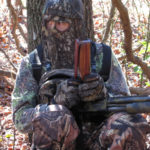
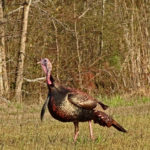
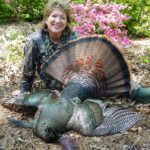
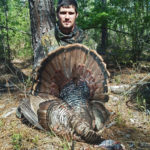



Be the first to comment